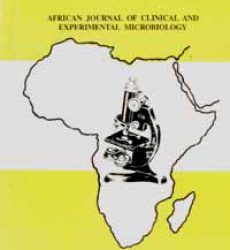Abstract
Background: Candiduria is a common finding. However, in immunocompromised patients like HIV-infected individuals, it has high risk of morbidity and mortality as it could be a pointer to systemic candidiasis. Unfortunately, there are no clear criteria for differentiating between colonization and infection or between upper or lower urinary tract infections.
Objective: This study focused on determining the spectrum of Candida species implicated in candiduria among HIV-infected individuals and their
susceptibility to fluconazole and voriconazole in a tertiary hospital.
Methods: A total of 300 subjects comprising of 200 HIV patients and 100 non-HIV individuals were used for this study. Clean catch midstream were collected from each individual and processed using standard microbiological techniques. Emergent Candida isolates were identified with CHROMagar Candida and sugar fermentation tests.
Results: The overall prevalence of candiduria among HIV patients was 13.5%. HAART-naive patients had a significantly higher prevalence (OR=4.165, 95%CI=1.602, 10.828; P=0.0038) than their counterpart on highly active antiretroviral therapy (HAART). Female gender was a significant risk factor for acquiring candiduria. Age had no significant effect on the prevalence of candiduria in this study. A CD4+ count <200 cells/µl was a significant risk factor for acquiring candiduria only among HAART-naive patients (OR=11.711; 95%CI=3.943, 34.780; P= 0.0001). The three species of Candida recovered from this study were C. albicans, C. krusei and C.parapsilosis. C. albicans (64.52%, 83.36%) and C. krusei (66.67%, 100.00%) were resistant to fluconazole and voriconazole respectively.
Conclusion: There is a significant relationship between antiretroviral therapy, CD4+ counts, and the prevalence of candiduria among the study population.
Keywords:HAART, HAART-naive, candiduria, CD4+ counts, Candida, prevalence.
Contexte: La candidurie est un problème commun de sante publique. Cependant, chez les patients immunodéprimés comme les individus infectés par le VIH, elle présente un risque élevé de morbidité puisqu’elle peut évoluer vers la candidose systémique. Malheureusement, il n’existe pas de critères clairs permettant de distinguer la colonisation et l’infection de même que les infections des voies urinaires supérieures et inférieures.
Objectif: Cette étude a porté sur la détermination du spectre d’espèces de Candida impliqués dans la candidurie chez les personnes infectées par le VIH et leur sensibilité au fluconazole et voriconazole dans un hôpital tertiaire.
Methodes : Un total de 300 sujets comprenant 200 patients atteints du VIH et 100 personnes non -VIH ont été utilisés dans cette étude. Les echantillons d’urine ont été collectées auprès de chaque personne par la methode de ‘‘Clean catch midstream’’et traitées en utilisant des techniques microbiologiques standard. Les isolats émergents de Candida ont été identifiés avec CHROMagar Candida et les tests de fermentation de sucre.
Résultats : La prévalence globale du VIH chez les patients atteints de candidurie était de 13,5%. Les patients en naïfs de la multithérapie HAARTavaient une prévalence significativement plus élevée (OR = 4,165, IC à 95% =1,602, 10,828, p = 0,0038 ) par rapport a leurs homologues sous traitement antiretroviral hautement actif (HAART ) . Le sexe feminin etait un facteur de risque important d’acquisition de candidurie. L’age n’avait pas d’effet significat nif sur la prevalence de candidurie dans cette etude. Un compte de CD4 + < 200 cellules / µl ete un facteur de risque important pour l’acquisition de candidurie que chez les patients en multitherapie naifs (OR = 11,711 ; IC a 95% = 3, 943, 34, 780, p = 0,0001). Les trois especes de Candida recuperes de cette etude etaient C. albicans, C. krusei et C.parapsilosis. C. albicans(64,52%, 83,36 %) et C. krusei (66,67%, 100,00 %) etaient resistants respectivement au fluconazole et voriconazole.
Conclusion: Il existe une relation significative entre le traitement antiretroviral, CD4 +, et la prevalence de candidurie parmi la population de l’etude..
Mots-cles: multitherapie HAART , naifs , candidurie , CD4 + , Candida , prevalence
Download full journal in PDF below
Candiduria among HIV- Infected Patients Attending a Tertiary Hospital in Benin City

